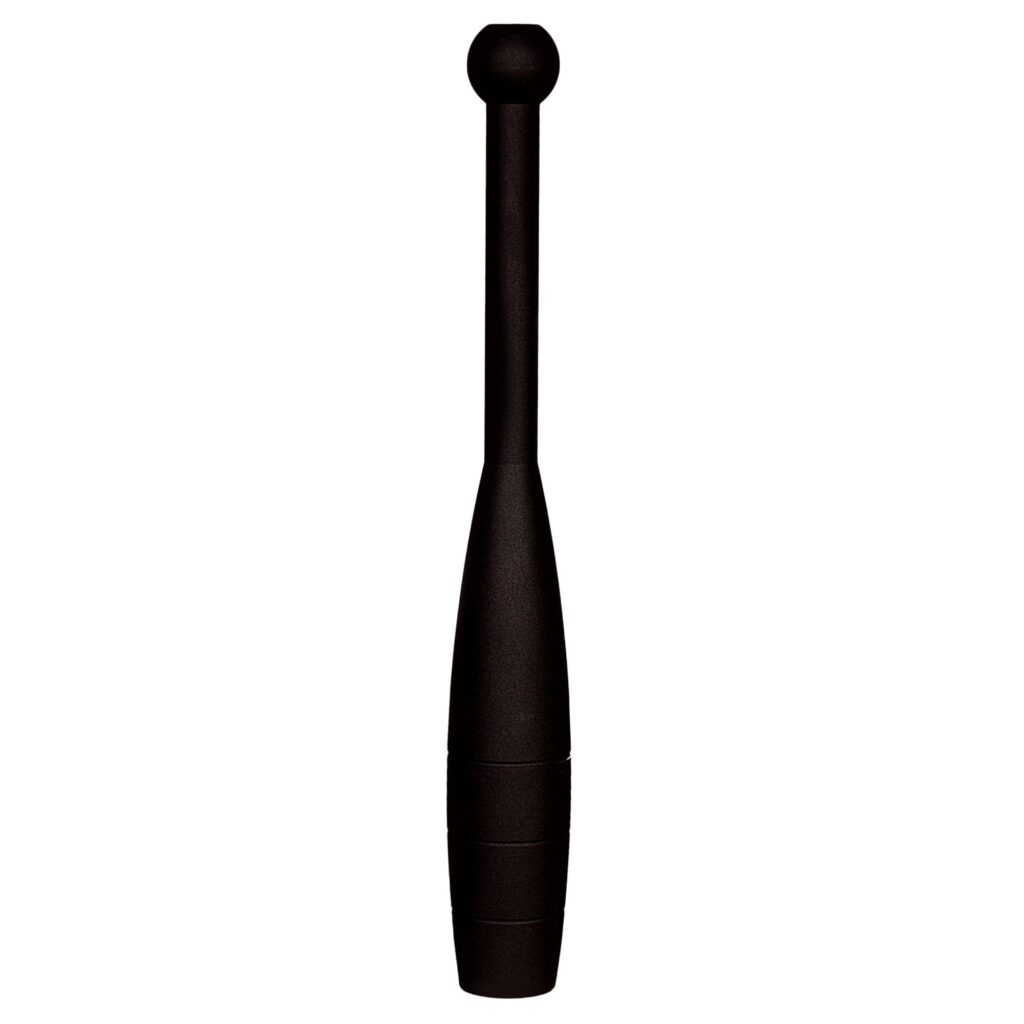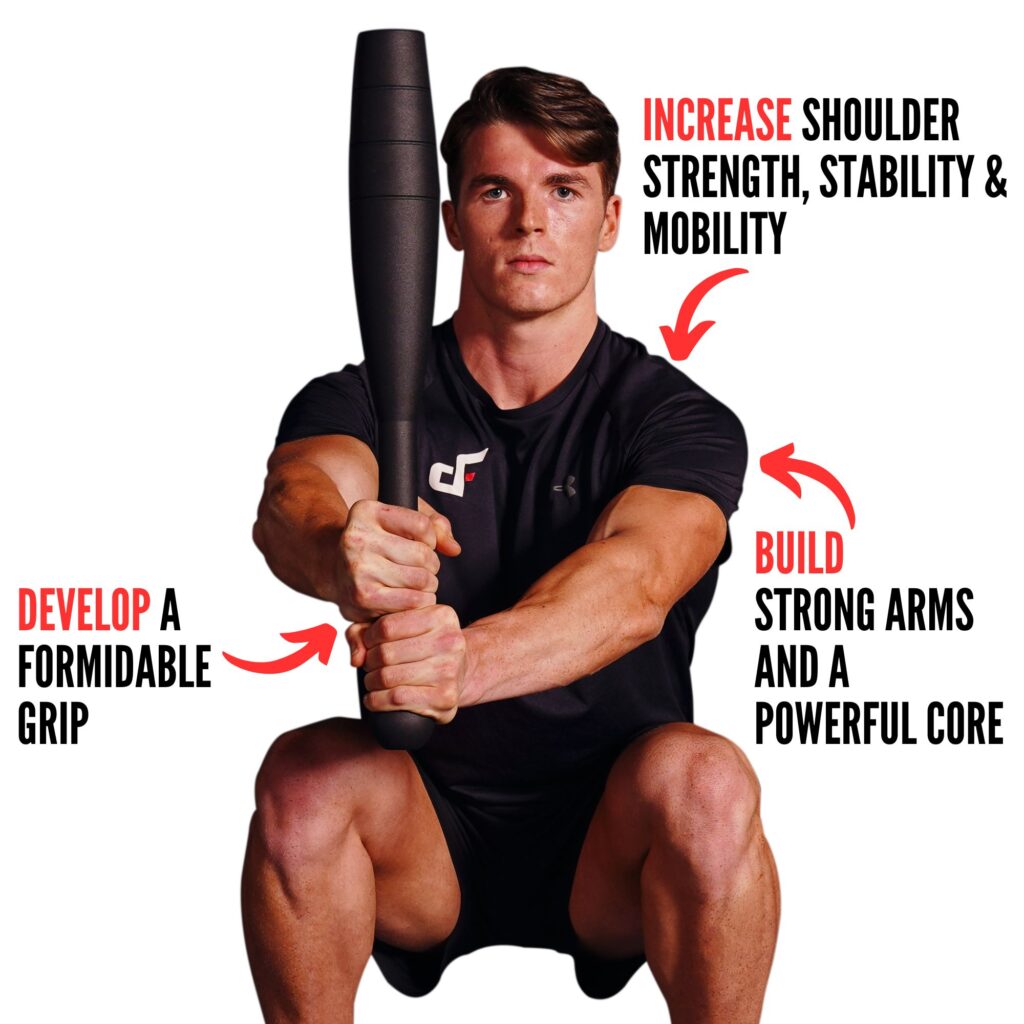

What is a Steel Clubbell?
Resembling a bowling pin in appearance, steel clubs carry a significant portion of their weight concentrated at the distant end (the barrel), far away from your grip. This unique design creates leverage which makes the clubbell feel heavier than it is.
Unlike the linear movements of conventional strength training tools, clubbells are swung around the body across various planes, generating substantial torque and tension that builds strength.
Forged from steel, the clubs weight range from 2kg to 20kg, offering remarkable versatility that complements prehab/rehab, dynamic flows, and full body strength and conditioning workouts.
Dangerously Fit’s Clubbells boast unrivaled quality on a global scale and develop real World functional strength like no other training tool.
Our clubs boast a powder-coated finish for enhanced grip and resistance to chipping. Crafted from a single machined steel piece, they feature an elongated handle for increased leverage, a spherical pommel end, a precisely balanced barrel, and sport a traditional Indian Club design.

Features

Weight in Kilograms

Powder Coating Finish
Powder-coated paint boasts a sleek yet tactile texture, enhancing grip even when your hands are sweaty. Moreover, this type of paint effectively retains chalk, outperforming alternatives such as matte or epoxy finishes.

Sphere Pommel
The pommel, positioned at the handle’s extremity, is ingeniously crafted to cradle the heel of your hand, effectively preventing the steel club from slipping during dynamic swinging motions.

Extended Handle

Perfectly Weighted Barrel

Precision-Crafted Steel

What Size Steel Clubbell Should I Buy?
Steel clubbells feel heavier than their actual weight due to the centre of mass of the club being so far away from the point of contact (your grip).
This leverage disparity is referred to as the leverage disadvantage, which contributes to the exceptional effectiveness and demanding nature of tools like steel clubs and steel maces.
An 8kg steel club will feel notably heavier than an 8kg kettlebell or dumbbell, underscoring the need to start with lighter weights while honing the necessary skills to control, stabilise and move the club.
Another thing to consider is your training goals. Lighter clubs are excellent for improving mobility, rehab and pre-rehab.
Medium-weight clubs are fantastic for conditioning and building muscle endurance, while heavier clubs are excellent for building strength.
For double exercises (one club in each hand), we suggest buying a pair of lighter clubbells, along with a heavier clubbell for your two-handed exercises.
The beauty of steel clubs lies in the flexibility of weight selection. Commencing with a pair of 4kg clubs for doubles and a 6kg club for two-handed exercises provides a solid foundation.
To progressively increase your workout load, simply purchase a single 6kg club for your double exercises and an 8kg club for your two-handed exercises.
Repeat this process as your proficiency and strength increases and you’re ready to tackle new challenges.

Weight Recommendations


Benefits of Steel Club Training
Grip Strength & Endurance
In contrast to traditional kettlebells, dumbbells, and barbells that feature a standard handle design which interacts with the skeletal structure (applying pressure on the fingers or nestling against the heel of the hand), the clubbell demands an active involvement of your forearm flexors during swinging. Swinging the clubs requires a deliberate engagement of your forearm flexors as they grip the club, countering its attempt to slip through your fingers.
Fun Full Body Workouts
Core Strength
Decompress Joints & Tissues
Shoulder Strength, Mobility & Stability
Rehab & Prehab
Lighter clubs are excellent for the rehabilitation of joints, tendons, and the more delicate muscles situated in the shoulder, elbow, and wrist.
Additionally, the clubbell is effectivel for priming and strengthening these pivotal areas before performing a rigorous workout, thereby mitigating the potential for injury and contributing to a proactive injury prevention strategy (prehab).
Multi-Planar Movement
The unique ability to swing the club across multiple planes distinguishes the steel clubbell (and steel mace) from conventional strength training equipment, which typically focuses on movements within the sagittal plane.
Transverse plane exercises, encompassing swinging, rotation, and twisting, and frontal plane exercises (side to side), often get missed in many strength and conditioning regimens, yet they constitute a vital component of a comprehensive training program.
Rotational Strength
The shape of clubbells make them ideally suited for performing swinging, chopping, and twisting movements that develop rotational force, commonly referred to as ‘torque.’ Only a handful of training tools have the ability to truly engage the body in rotational movement patterns, the steel club takes transverse plane training to an entirely unprecedented level.
The Origins of Club Training
An Ancient Weapon of War
The club, a training tool dating back thousands of years, was originally used in ancient Persia where warriors used it to develop robust shoulders and create a formidable grip essential for wielding weighty weapons in warfare.
Throughout history, warriors across diverse cultures adopted club training to replicate the chopping actions prevalent in battle. Recognizing the potency of mighty shoulders and a powerful grip, these warriors understood the importance of a deadly blow against their opponents.
As body armor evolved, heavy club training emerged, enabling warriors to wield more substantial weaponry capable of penetrating advanced defensive armor.
In subsequent eras, the club became a cornerstone in the training regimens of martial artists, including those from Persia (Pahlavani), India (Kalaripayat), and Russia (SAMBO). Its applications encompassed strength building, enhanced mobility, and the rejuvenation of joints and connective tissues.
The trajectory of the club extended to Europe and the Western world when British soldiers stationed in India during the 19th century embraced them. Later, both the US and British military integrated club training into their physical conditioning programs, with Indian clubs even making appearances as a sport in the 1904 and 1932 Olympic games.
However, the advent of machine weights and pulley systems triggered a decline in the popularity of Indian Club training, as the focus shifted towards lifting heavier weights rather than prioritizing functional movement.
In recent times, a resurgence of interest in Indian clubs and heavy steel clubbells has emerged, particularly among athletes and fitness enthusiasts seeking heightened circular shoulder strength, grip strength, and rotational core power. This revival emphasises the enduring relevance of club training in enhancing functional athleticism.


Clubbell Exercises
Conventional clubbell movements like mills and shield casts are exceptional in building durable shoulders, a strong core, and a powerful grip.
Yet, the potential of the club extends beyond upper body strength alone.
This remarkably versatile tool offers a wide range of applications, effectively challenging the entire body.
The adaptability inherent in steel clubs lends itself seamlessly to ‘clubbell flow’ workouts, wherein a series of three or more exercises are executed in a cohesive sequence, devoid of rest intervals.
To delve deeper into the realm of steel club exercises and immersive steel club flow workouts, explore the comprehensive Steel Club Supremacy Certification offered below. The Steel Club Supremacy encompasses both level 1 and level 2 steel club certification courses.
Within ‘Steel Club Supremacy,’ you’ll uncover a treasure trove of 83 distinct steel club exercises, encompassing techniques such as bullwhips, mills, 180-degree movements, and a wealth of additional exercises, providing a complete mastery of steel club training.
Steel Club Supremacy Certification
Reviews

Moe Moon

Luke Carr

Deborah Layton

Alex Lopez

Naoki Nakasone

Col Weary
Popular Clubbell Exercises
Clubbell Reverse Mill
Clubbell Clock Squat
Clubbell Shield Cast
Clubbell Double Mill
Clubbell Bullwhip
Clubbell Outside 180’s
Our superior quality clubbells are available for shipping across New Zealand, with swift and cost-effective delivery catering to al major cities such as Auckland, Wellington, Christchurch, Hamilton, Tauranga and more. For global customers, worldwide shipping options are also available.


